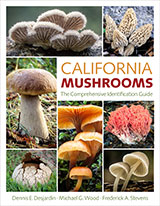The North American Species of Pholiota
32. Pholiota davidsonii sp. nov.
Illustrations: Text figs. 47-48.
Pileus 2-3 cm latus, late convexus, luteofulvus, glaber viscidus. Caro luteola. Lamellae subdecurrentes, brunneae, confertae, latae. Stipes 2-3 cm longus, 3-5 mm crassus, obscure pallidus, sursum pruinosus, deorsum fibrillosus. Sporae 8-10 (12) x 4-5 (6-6.5) µ. Pleurocystidia desunt. Cheilocystidia 20-32 x 5-7 µ, subcylindrica vel subventricosa, tenuitunicata. Caulocystidia clavata, 8-15 µ diam. Specimen typicum in Herb. Univ. Mich. conservatum est; legit. prope Estes Park, Colorado, (Rocky Mts. Nat'l. Park), Ross Davidson 112.
Pileus 2-3 cm broad, convex, slightly hemispheric, yellowish tawny, glabrous, slightly viscid when wet. Context thick on disc, thin on margin. tinged yellowish.
Lamellae adnate-subdecurrent, brown (color when young not recorded), close, broad, edges whitish and minutely fimbriate.
Stipe 2-3 cm long, 3-5 mm thick, dingy-pallid, apex pruinose, elsewhere sparsely fibrillose, equal. Veil white, rather heavy-arachnoid but not membranous, appendiculate, fugaceous.
Spores 8-10 (12) x 4-5 (6-6.5) µ, smooth, dark rusty brown in KOH, a paler tawny-cinnamon in Melzer's sol., smooth, with a distinct apical germ pore which in the giant spores causes the apex to appear truncate; elliptic to ovate in face view, somewhat inequilateral in profile; wall 0.3-0.5 µ thick (estimated).
Basidia 25-32 x 6-8 µ, 4-spored or rarely 2-spored (large spores seen in diads.), hyaline in KOH and yellowish in Melzer's reagent. Pleurocystidia none. Cheilocystidia very inconspicuous, 20-32 x 5-7 µ, buried in the hymenium of the gill-edge, subcylindric to ventricose or a few fusoid-ventricose, thin-walled, hyaline in KOH, content homogeneous. Caulocystidia present as clavate end-cells of stipe hyphae, 8-15 µ diam. and variable in length, hyaline, walls thin and smooth, content homogeneous.
Gill trama of floccose hyphae 5-10 µ diam. (gills all young) somewhat interwoven to parallel; walls thin, smooth and hyaline to yellowish revived in KOH; subhymenium of cellular construction and not gelatinous, the cells 4-8 µ diam. Pileus cutis a layer of hyphae 3-6 µ diam. with incrusted walls, the zone refractive in KOH indicating presence of slime but individual hyphae clearly delimited; hypodermial zone of more deeply colored incrusted hyphae. Context hyphae hyaline to yellowish in KOH, 6-15 µ diam; smooth, thin-walled. All hyphae inamyloid. Clamp connections present.
Habit, Habitat, and Distribution: On soil under spruce. Aug. 28, 1959, Rocky Mts. National Park, Colo., Ross Davidson 112, type.
Observations: This species although described from rather young specimens is worth placing on record as it shows that two-spored basidia very likely produce the large spores which are truncate at the apex, whereas the 4-spored basidia produce spores with the apical pore distinct but the spore apex is not truncate. It is because of such species as this that we have abandoned Kuehneromyces as a genus.
In our description the measurements of the basidiocarp are from dried immature specimens, but the spores have been studied both from a deposit and from the gills of the oldest basidiocarp. This species is to be regarded as having about the stature and proportions of Pholiota spumosa. Since cystidial features are more reliable at the time sporulation begins, we believe that the absence of pleurocystidia and the very inconspicuous cheilocystidia can be trusted to be reliable species characters here.
The dried basidiocarps remind one of Naematoloma capnoides to a great extent, but spore features and the absence of chrysocystidia rule this out. It is named in honor of the collector, Dr. Ross Davidson who has worked so much on the forest fungi of the Rocky Mountains.

